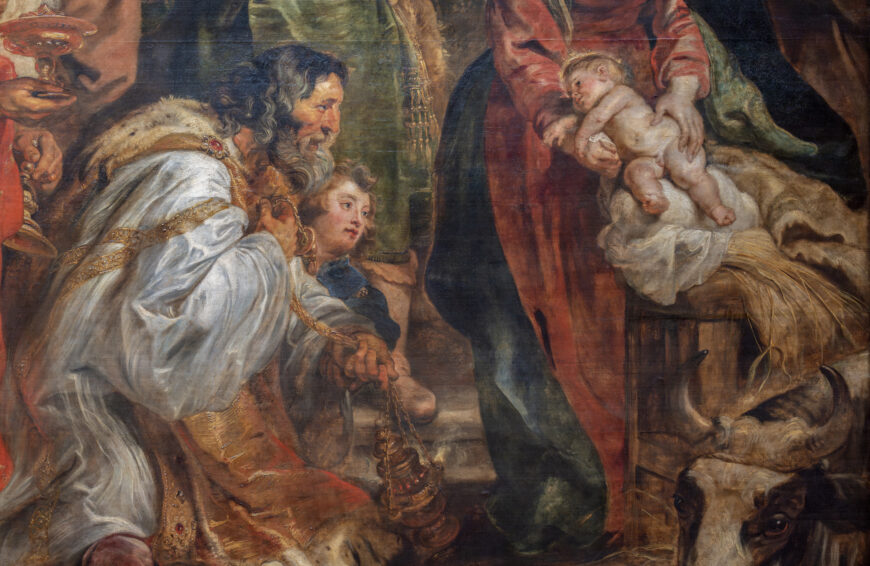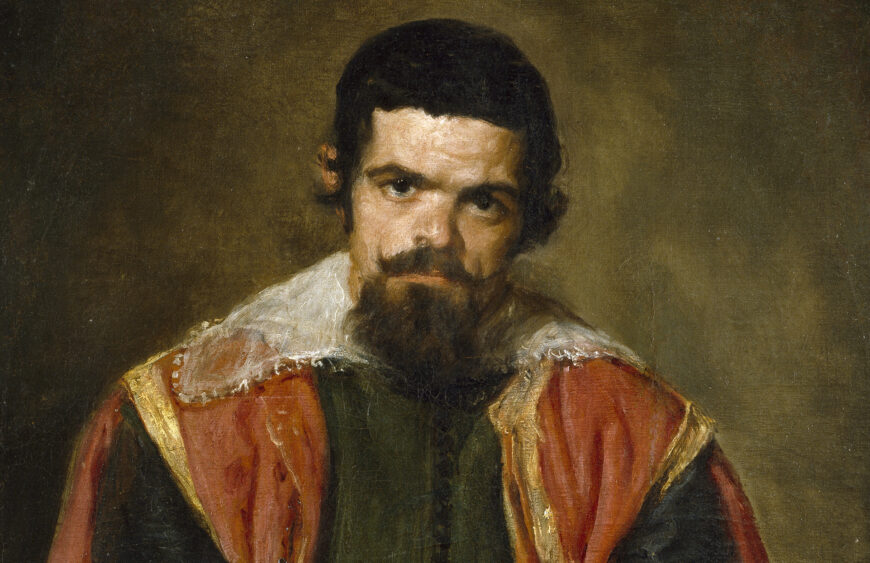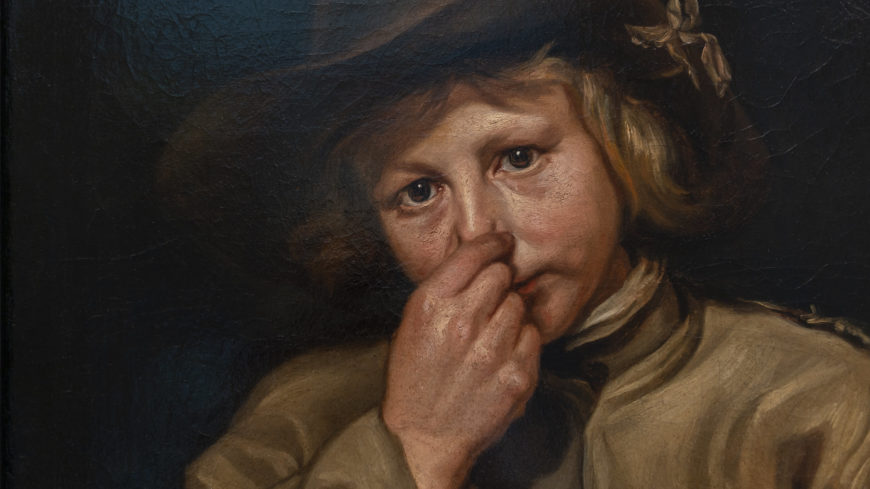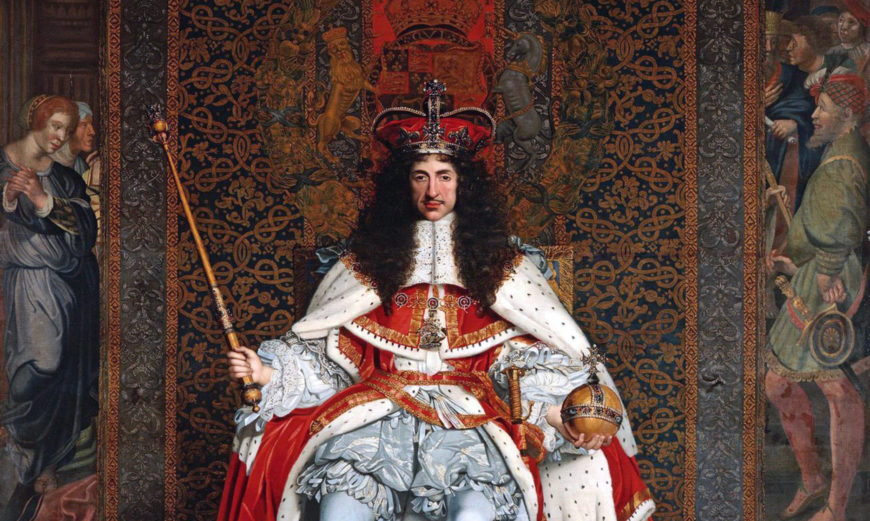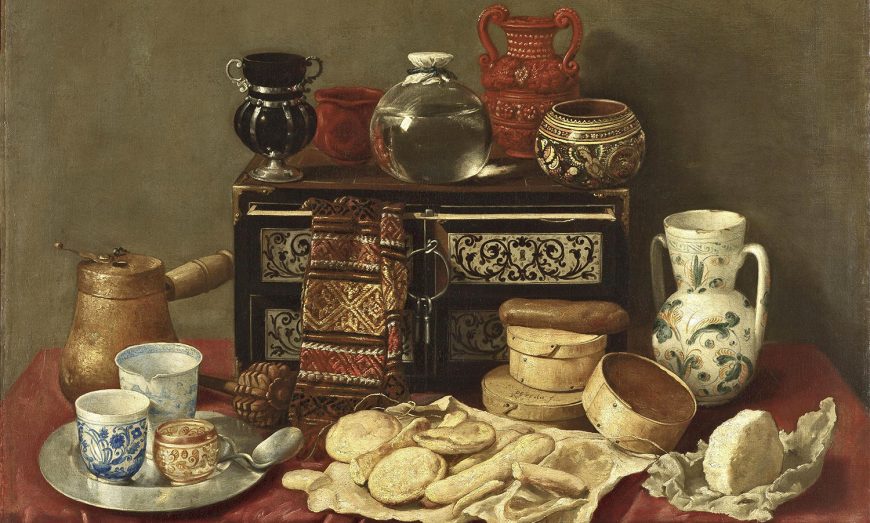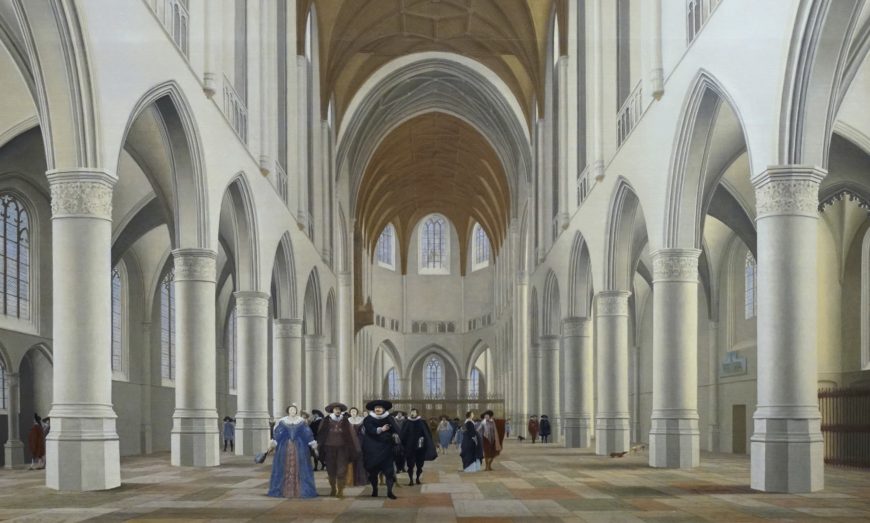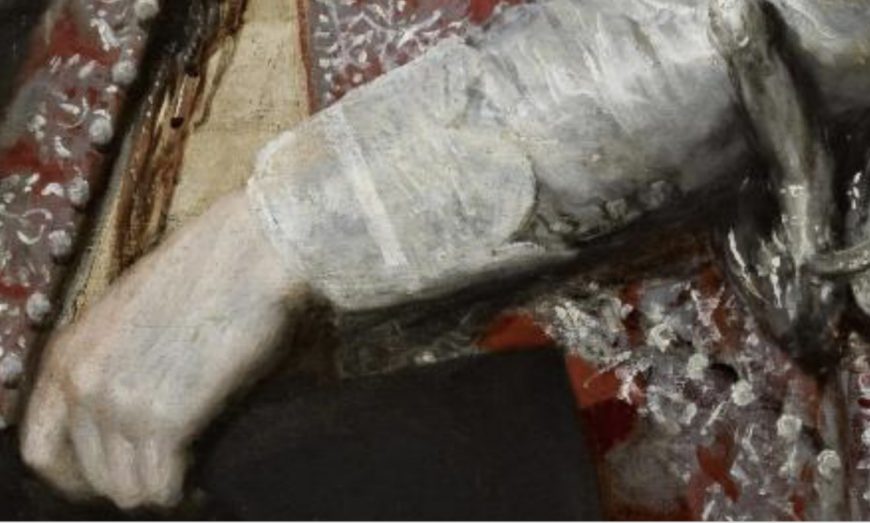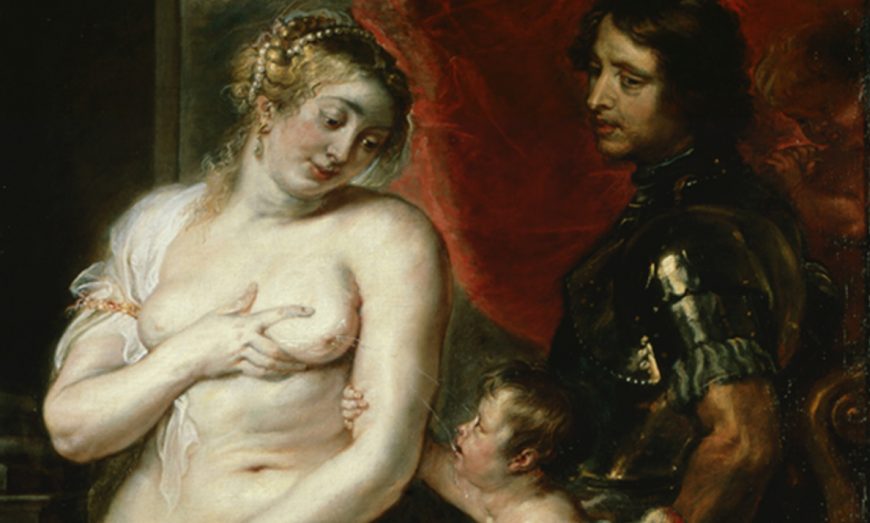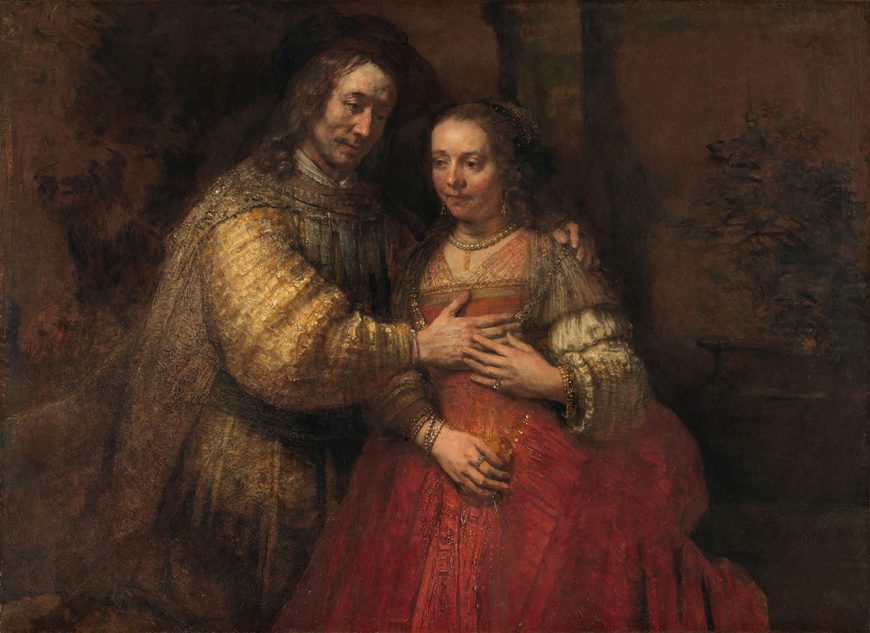
Rembrandt van Rijn, Portrait of a Couple as Isaac and Rebecca, known as The Jewish Bride, 1665-69, oil on canvas, 121.5 x 166.5 cm (Rijksmuseum, Amsterdam)
Portrait of a Couple as Isaac and Rebecca, commonly known as The Jewish Bride, is a painter’s painting. According to his letters, Vincent van Gogh was reduced to tears in front of it, writing that he would gladly give up ten years of his life to sit in front of the painting for two weeks, eating only a stale crust of bread. Though modern viewers may require slightly more sustenance, the power of the image remains.
In the center of a horizontally-oriented canvas, a woman in a luxurious red dress stands with her wrists and neck draped in pearls. Her companion stands to her right, one arm reaching behind her, the other reaching out to lay a hand at her breast. He is equally richly dressed in a vertically pleated garment over a shirt in shades of gold and brown. The fingers of her left hand gently rest on his in a touching, protective gesture. The two figures, despite the intimacy of their gesture, do not look at each other, nor do they look at the viewer. They are alone in this moment, set beside an arch and a potted plant barely indicated in shades of dark, mottled brown.
Late in Rembrandt’s career
Rembrandt van Rijn painted this canvas very late in his career. Though born in the Dutch city of Leiden, Rembrandt worked primarily in Amsterdam. There, he built up an impressive local clientele who were eager for his expressive portraits and, later, for his psychologically complex history paintings. His late paintings were intended for a smaller, more selective audience who would appreciate the idiosyncrasies of both the painter and his work. Some scholars have seen the last decade of Rembrandt’s life as a period of decline, yet it is also the decade that yielded many of his most cherished, complex, and psychologically-nuanced works. Paintings from this period are characterized by rich earth tones, in some areas thinly painted and in others applied in a thick impasto.
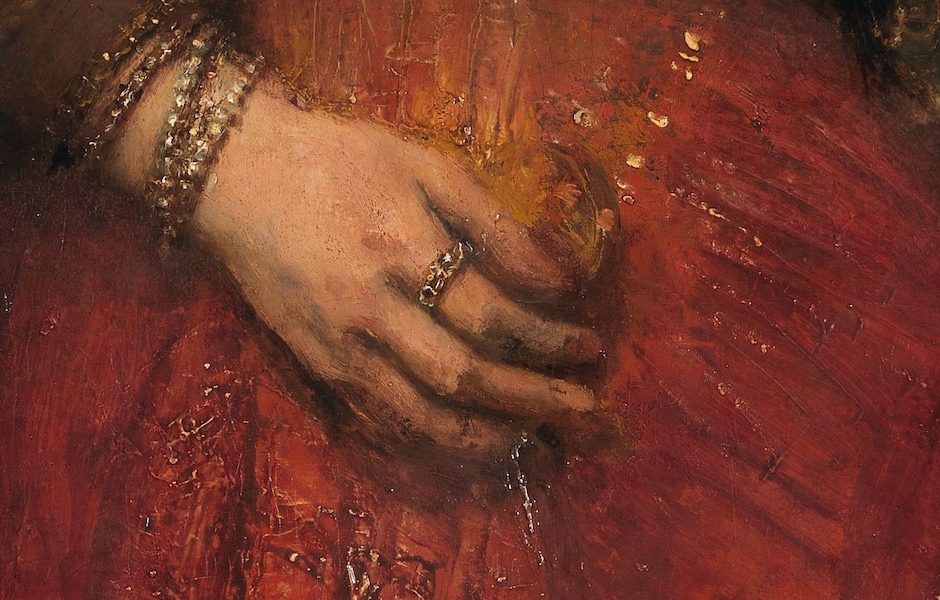
Hand and skirt (detail), Rembrandt van Rijn, Portrait of a Couple as Isaac and Rebecca, known as The Jewish Bride, 1665-69, oil on canvas, 121.5 x 166.5 cm (Rijksmuseum, Amsterdam)
For example, in The Jewish Bride clearly visible heavy slashes of paint create the texture of the folds of the woman’s skirt, while smaller and more delicate highlights of white and gold pick out the rings on her fingers, the pearls at her neck and wrist, and the decoration of her dress.
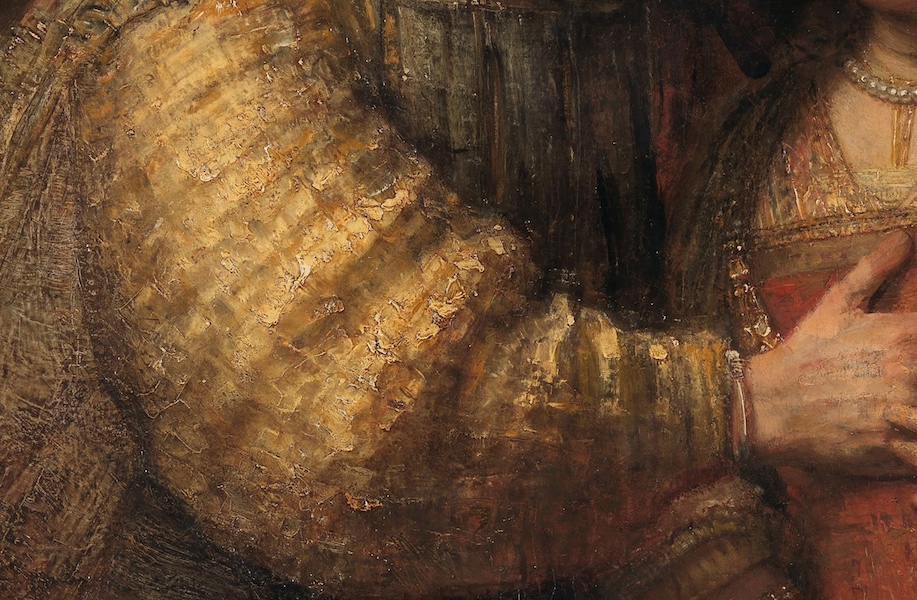
Sleeve (detail), Rembrandt van Rijn, detail of Portrait of a Couple as Isaac and Rebecca, known as The Jewish Bride, 1665-69, oil on canvas, 121.5 x 166.5 cm (Rijksmuseum, Amsterdam)
The almost sculptural quality of the paint is repeated in the man’s clothes as well. The small, square brushstrokes that form the man’s voluminous right sleeve work almost like tesserae in a mosaic to create a shimmering golden texture. Even the treatment of their faces reveals the hand of the artist moving over the canvas, building up the skin tones from a range of colors. Rembrandt uses the depiction of surfaces and the surface texture of the paint itself to direct our attention, allowing everything less important to literally dissolve into darkness and obscurity.
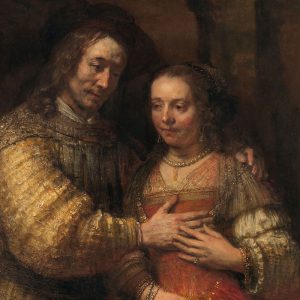
Detail, Rembrandt van Rijn, Portrait of a Couple as Isaac and Rebecca, known as The Jewish Bride, 1665-69, oil on canvas, 121.5 x 166.5 cm (Rijksmuseum, Amsterdam)
Who are the sitters?
Portrait of a Couple as Isaac and Rebecca has attracted more than its fair share of theories over the years, with ambiguity on every level. Who is represented? Is this a double portrait or a scene from a narrative? Who commissioned it and where was it hung? Was the canvas cut down at some point, or is this the whole composition? Despite substantial scholarship, many of these questions evade firm answers.
Like Rembrandt’s famous Night Watch, this painting is most commonly called by its nickname, The Jewish Bride. The nickname was a nineteenth-century addition, as there is no evidence for such a title in any seventeenth-century literature. The identification of the subject has generated a great deal of debate. At one point, it was maintained that this was a portrait of Rembrandt’s son Titus and his wife, though other theories have included a father-daughter identification.
Most commonly accepted, however, is the identification of the figures as the Biblical couple Isaac and Rebecca. There are many textual and visual sources that support this identification. The story of this couple is found in the Old Testament in the book of Genesis: Isaac and Rebecca were seeking refuge in the lands of the king Abimelech. Fearing that the locals might kill him because of his wife’s beauty, Isaac claimed that Rebecca was his sister, not his wife. They were, however, caught in a moment of intimacy by Abimelech, revealing their true relationship. Abimelech reprimanded them for their deceit, but also commanded that no one harm them. Isaac and Rebecca are the model married couple: she is modest, beautiful, and obedient while he is faithful, steadfast, and strong in his faith.
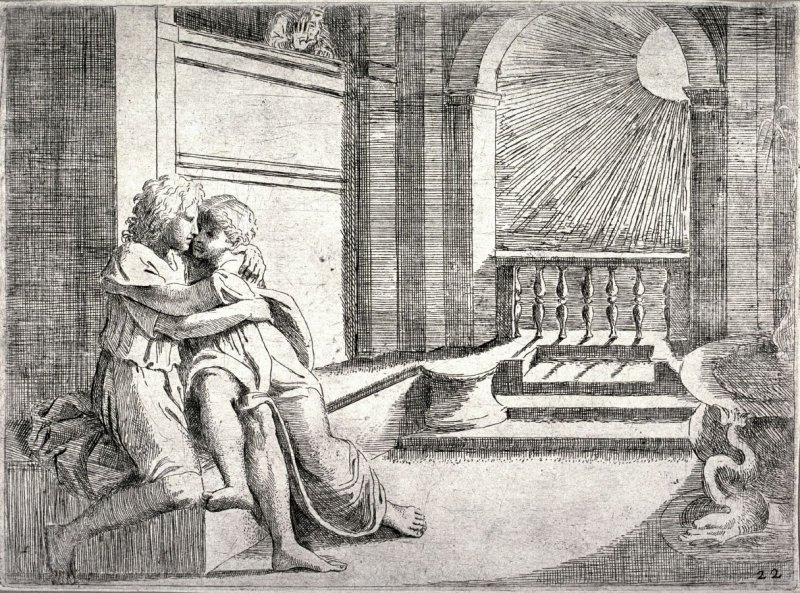
Sisto Badalocchio, Isaac and Rebecca Spied upon by Abimelech, from a series of etchings of Biblical scenes, after frescoes by Raphael in the Vatican Loggia, 1607, etching, 13.1 x 17.9 cm (Fine Arts Museums of San Francisco)
An intimate moment
Earlier works by Rembrandt and other artists support the identification of the subject and reveal how Rembrandt evoked and manipulated earlier compositions. A drawing, now in a private collection in the United States, reveals the characteristic and instantly recognizable gesture of the man reaching out to place a caressing hand on the breast of the woman. The earlier drawing differs, though, in that the spying Abimelech is just visible in a window in the top right corner, barely sketched in. In turn, this composition seems to be based on an earlier print by Sisto Badolocchio (above) after a Raphael fresco in the Vatican. Rembrandt’s subject matter therefore has an eminent pedigree.
By altering the composition between the drawing and the painting, Rembrandt has made an important shift in focus. In leaving out Abimelech, he has chosen to focus the attention of the viewer not on the larger narrative, but instead on a moment of intimacy between the two figures. In addition, as Jonathan Bikker has recently pointed out, leaving Abimelech out of the image casts us, the viewer, in the role of the spying king. This directly involves us in the scene, blurring the boundary between painting and life; we, too, are spying on an intimate moment.
A popular type of portrait
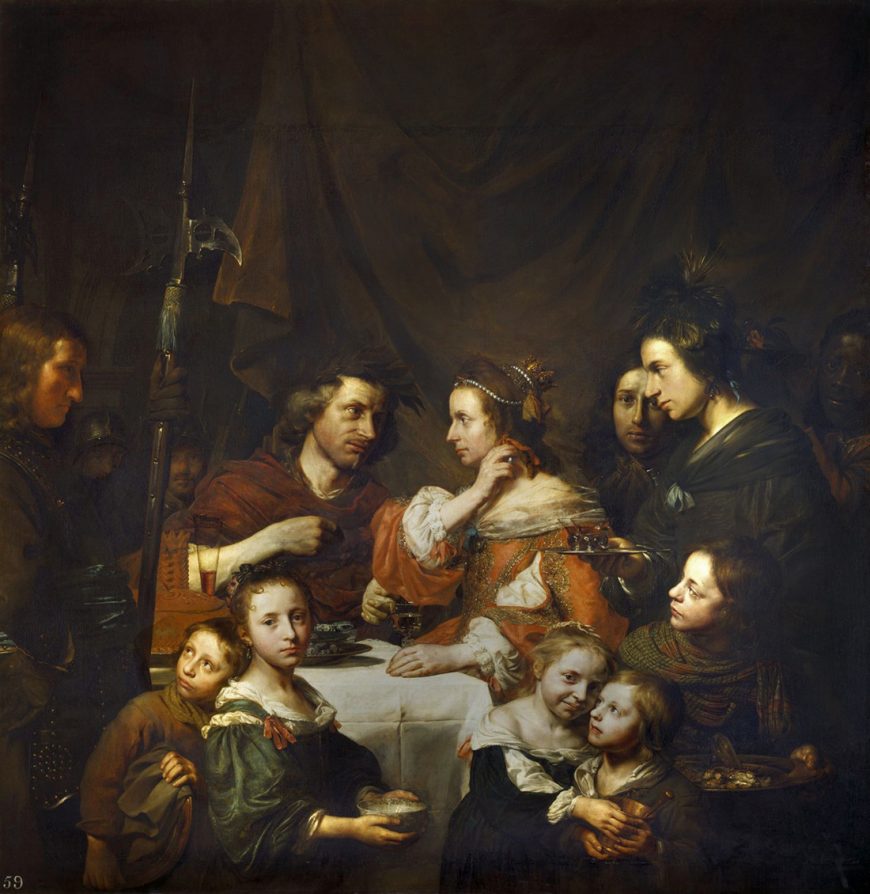
Jan de Bray, The Banquet of Cleopatra, 1652, oil on canvas, 170.7 x 165.8 cm (Royal Collection Trust)
The size, lack of scenery, and intimate focus on two figures supports the idea that this was intended as a particular type of portrait: a portrait historié or historiated portrait, where two real people “dressed up” for their portrait.
Having one’s portrait painted in the guise of an historical or biblical figure may seem strange to us now, but the portrait historié was surprisingly common in the Dutch Golden Age (17th century). Whether the patrons were dressing up as biblical figures (and thereby hoping to lay claim to their virtues), or as mythological figures (demonstrating erudition or theatrical ties), historiated portraits existed comfortably alongside the more typical portraits of stern-faced people wearing black.
Jan de Bray depicted his family as figures in the banquet of Antony and Cleopatra, while the children of the exiled king and queen of Bohemia were depicted by Gerrit van Honthorst in the guises of Roman gods. In the case of The Jewish Bride, by choosing to be depicted as Isaac and Rebecca, the sitters were choosing to emphasize their fidelity and piety as well as suggesting to any viewer that their marriage was a happy and virtuous one.
The Jewish Bride is an example of the aging Rembrandt at his finest. He is both perfectly in step with broader trends in Dutch painting such as the portrait historié while also maintaining the distinctive artistic identity that his late patrons appreciated.



